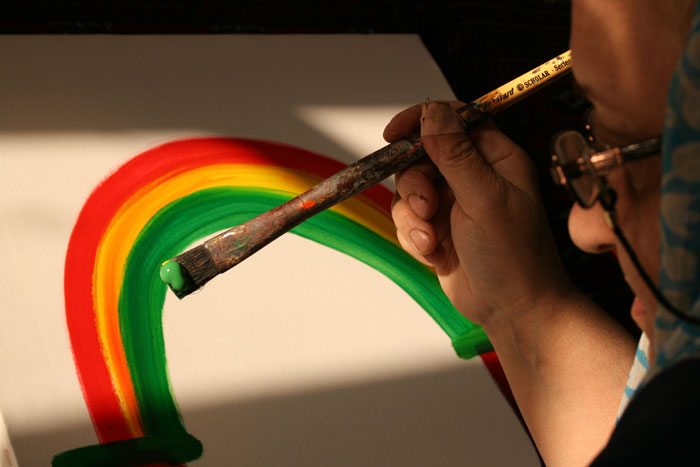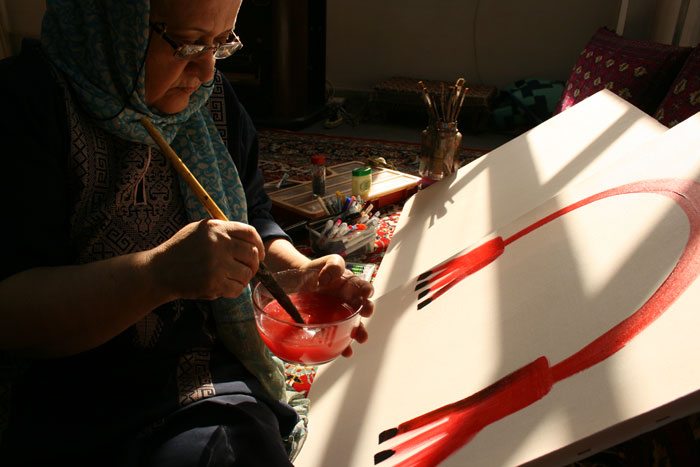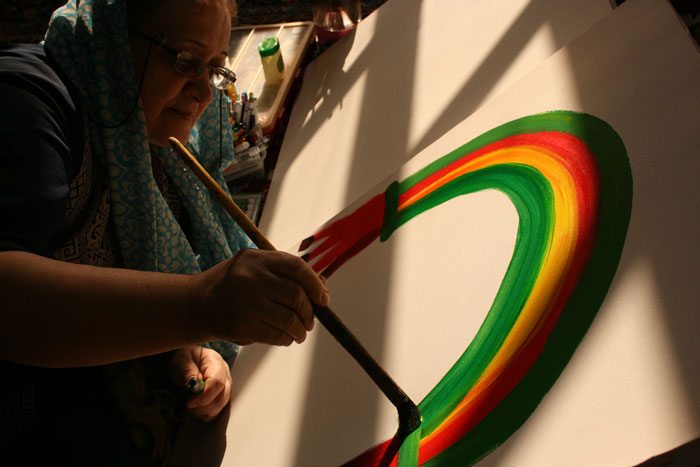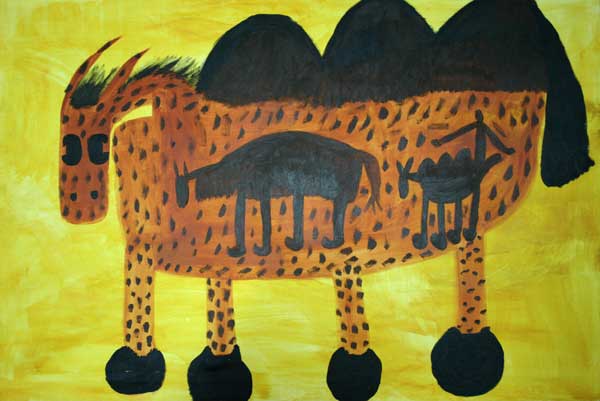Late discovery

It was incidentally that she found out how much she loves to paint. The fifty years old uneducated grandmother discovered this when her little grandchild asked to draw a painting for her. “Absolutely not”, her grandmother said, because she believed that she couldn’t. But, because the little girl persisted, she accepted and tried to draw the Kaaba for her. This was her first piece ever, and the initial step towards her life as an artist.
Akram Sartakhti was born in 1950 in Ray, south of Tehran. She got married at the very young age of nine with a twenty-six years old man and now has three children: two daughters and one son. She never got the chance to go to school, so she can neither read nor write. Letters, lines and words – she is not familiar with them at all. As a mother and wife, Sartakhti had to take care of her family instead of playing with other kids. Being only a child herself, it was a difficult task, but like most housewives she tried her best to juggle between the housework and looking after her children. There was simply no time to develop her own interests.
Sartakhti knew immediately that she liked painting. There were paintings hidden under the carpet in her private room beyond the yard: out of sight for all but herself.

A lifetime later, on the day that she drew the Kaaba, Sartakhti knew immediately that she liked painting. And after her second, third and fourth piece, she could think of nothing other than shapes and colours. One week later, there were seven selected pieces of paintings hidden under the carpet in her private room beyond the yard: out of sight for all but herself.
At first, she used to paint stealthily when nobody was home. Most of the time she tore and threw her paintings away, but gradually, she decided to keep the ones that she liked. Worried about the reactions of other people – not to mention her own children – she hid her works under the carpet. Indeed, in traditional families it’s strange for a woman of her age to paint: that’s something that children do. In the end however, she overcame her fear and showed the paintings to her son. He was her first viewer and also the one who encouraged her to continue.
At first, she used to paint stealthily when nobody was home. Most of the time she tore and threw her paintings away, but gradually, she decided to keep the ones that she liked.
Since then, Sartakhti has worked nonstop, day and night. She hasn’t been trained in painting techniques and styles, and never studied for a teacher. Instead, she has her very own style which makes her paintings both unique and authentic. Most of the subjects displayed in her early works were borrowed from sweet and bitter moments of her own life or legends and religious myths, but later she included portraits, figures, animals and imaginative creatures.

Her favourite themes are ladders, animals, devils and birds, as well as pregnant animals and women. She explains these symbols, as well as the different colours she uses in her work. Ladders represent the ascending to God and light, birds with dark colours refer to evil and the ones with bright colours to good. The colour of green represents luck as well as the light of God, while black means both night and calmness.
Her works have been compared with Pablo Picasso and Paul Klee, maybe because of their simplicity, effectiveness and similarity to kid’s drawings.
All in all, Sartakhti has made more than 2000 paintings using a wide range of techniques: oil, gouache, magic marker, watercolour, ink, scratch, pastel, colour pencils, acrylic on canvas, pasteboard, paper, ceramic, earthenware, wood, glass, and all sorts of things that she finds around the house. She has participated in several solo and group exhibitions in Iran and is an honorary member of The Iranian Developing Art Foundation and Painters Association of Iran.
Sartakhti is now sixty years old, and ten years have passed since the day when she first started painting. Her works have improved in both content and number. They have been compared with Pablo Picasso and Paul Klee, maybe because of their simplicity, effectiveness and similarity to kid’s drawings. She doesn’t hide her paintings anymore: on the contrary she now likes to work on big canvases, and is eager to hold exhibitions and see the reactions of her visitors.


For those who would like to experience Sartakhti’s artwork, Nazar Art Publication will publish a selection collected by her daughter Tooba.
2 thoughts on “Late discovery”
Comments are closed.







Please help me find her contact, I love her painting and wish to buy her paintings. I am a Brazilian. thank you very much.